2005 HYUNDAI XG350 check engine
[x] Cancel search: check enginePage 191 of 247
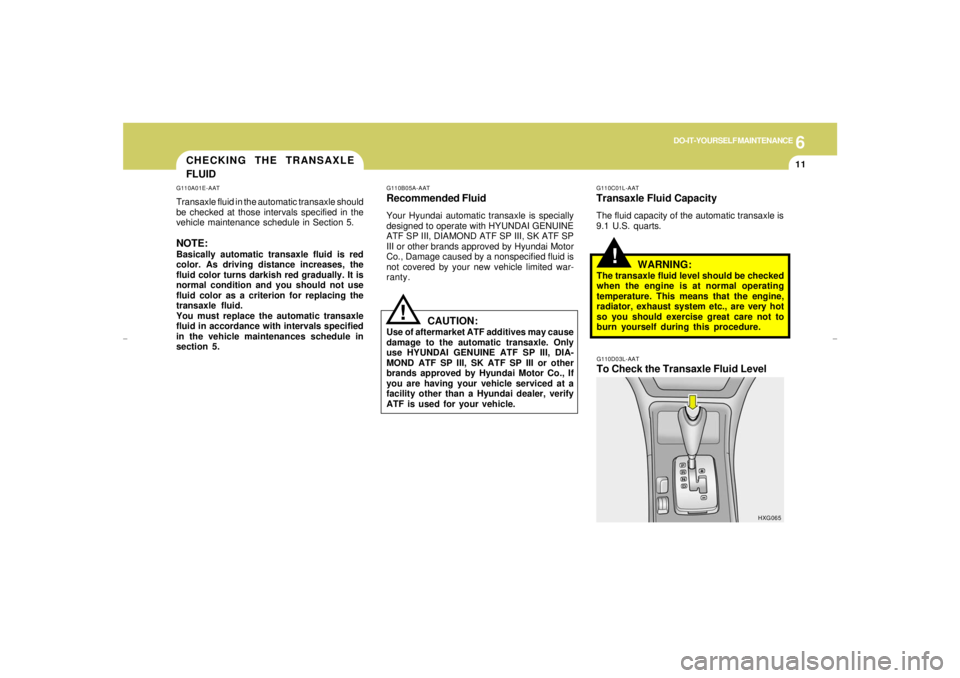
6
DO-IT-YOURSELF MAINTENANCE
11
CHECKING THE TRANSAXLE
FLUID
!
G110A01E-AATTransaxle fluid in the automatic transaxle should
be checked at those intervals specified in the
vehicle maintenance schedule in Section 5.NOTE:Basically automatic transaxle fluid is red
color. As driving distance increases, the
fluid color turns darkish red gradually. It is
normal condition and you should not use
fluid color as a criterion for replacing the
transaxle fluid.
You must replace the automatic transaxle
fluid in accordance with intervals specified
in the vehicle maintenances schedule in
section 5.
G110B05A-AATRecommended FluidYour Hyundai automatic transaxle is specially
designed to operate with HYUNDAI GENUINE
ATF SP III, DIAMOND ATF SP III, SK ATF SP
III or other brands approved by Hyundai Motor
Co., Damage caused by a nonspecified fluid is
not covered by your new vehicle limited war-
ranty.
G110C01L-AATTransaxle Fluid CapacityThe fluid capacity of the automatic transaxle is
9.1 U.S. quarts.
WARNING:
The transaxle fluid level should be checked
when the engine is at normal operating
temperature. This means that the engine,
radiator, exhaust system etc., are very hot
so you should exercise great care not to
burn yourself during this procedure.
CAUTION:
Use of aftermarket ATF additives may cause
damage to the automatic transaxle. Only
use HYUNDAI GENUINE ATF SP III, DIA-
MOND ATF SP III, SK ATF SP III or other
brands approved by Hyundai Motor Co., If
you are having your vehicle serviced at a
facility other than a Hyundai dealer, verify
ATF is used for your vehicle.
!
G110D03L-AATTo Check the Transaxle Fluid Level
HXG065
xgflhma-6.p656/16/04, 2:58 PM 11
Page 192 of 247
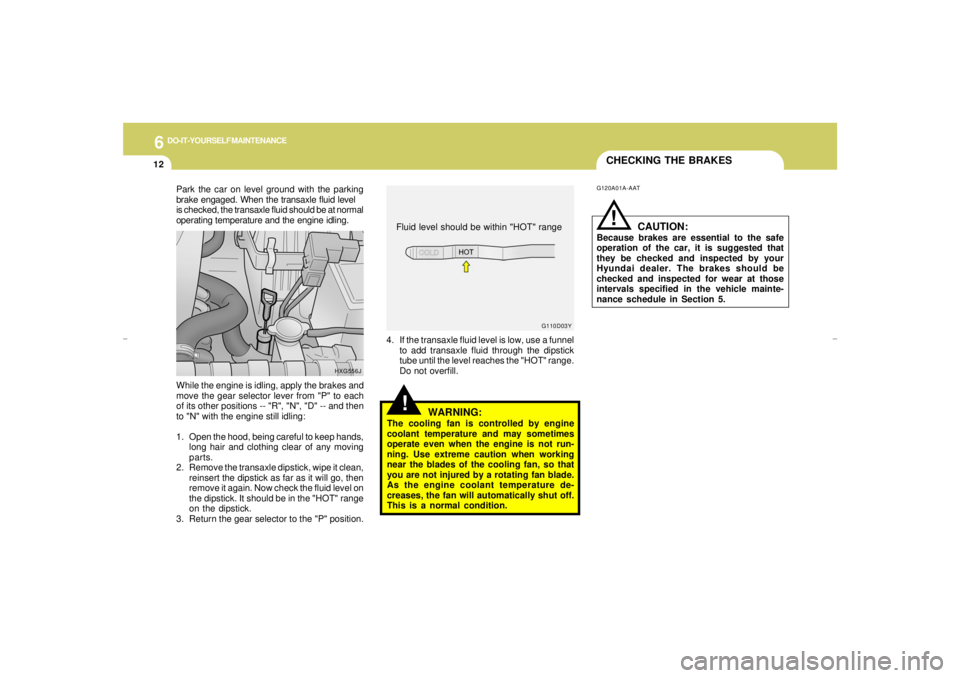
6
DO-IT-YOURSELF MAINTENANCE
12
CHECKING THE BRAKES
!
WARNING:
The cooling fan is controlled by engine
coolant temperature and may sometimes
operate even when the engine is not run-
ning. Use extreme caution when working
near the blades of the cooling fan, so that
you are not injured by a rotating fan blade.
As the engine coolant temperature de-
creases, the fan will automatically shut off.
This is a normal condition.
G110D03Y
Fluid level should be within "HOT" range
4. If the transaxle fluid level is low, use a funnel
to add transaxle fluid through the dipstick
tube until the level reaches the "HOT" range.
Do not overfill.
G120A01A-AAT
CAUTION:
Because brakes are essential to the safe
operation of the car, it is suggested that
they be checked and inspected by your
Hyundai dealer. The brakes should be
checked and inspected for wear at those
intervals specified in the vehicle mainte-
nance schedule in Section 5.
While the engine is idling, apply the brakes and
move the gear selector lever from "P" to each
of its other positions -- "R", "N", "D" -- and then
to "N" with the engine still idling:
1. Open the hood, being careful to keep hands,
long hair and clothing clear of any moving
parts.
2. Remove the transaxle dipstick, wipe it clean,
reinsert the dipstick as far as it will go, then
remove it again. Now check the fluid level on
the dipstick. It should be in the "HOT" range
on the dipstick.
3. Return the gear selector to the "P" position.
HXG556J
!
Park the car on level ground with the parking
brake engaged. When the transaxle fluid level
is checked, the transaxle fluid should be at normal
operating temperature and the engine idling.
xgflhma-6.p656/16/04, 2:58 PM 12
Page 194 of 247
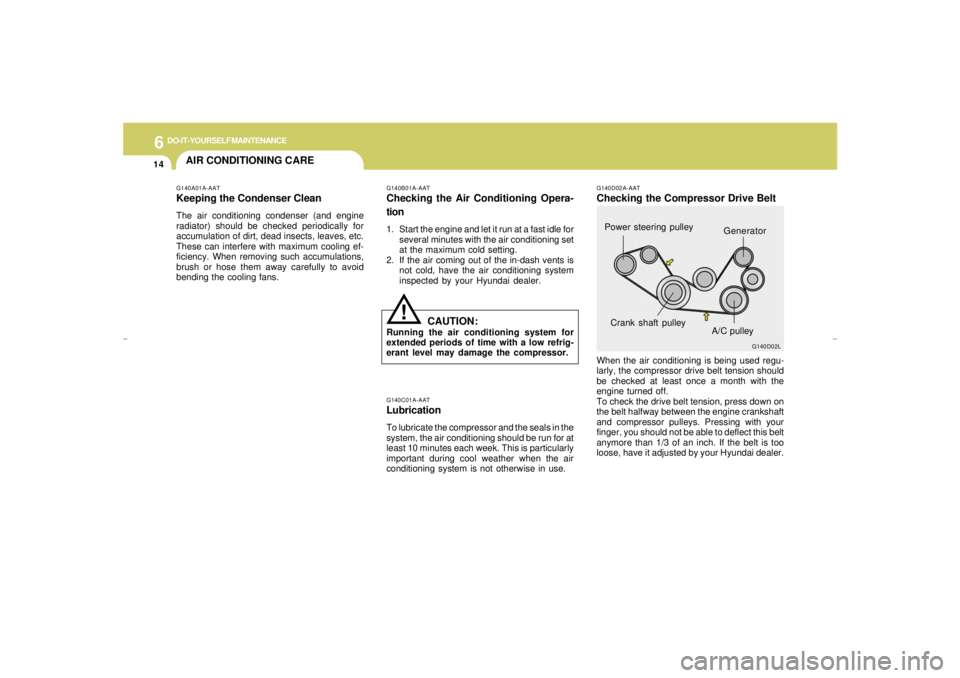
6
DO-IT-YOURSELF MAINTENANCE
14
AIR CONDITIONING CARE
G140D02A-AATChecking the Compressor Drive BeltWhen the air conditioning is being used regu-
larly, the compressor drive belt tension should
be checked at least once a month with the
engine turned off.
To check the drive belt tension, press down on
the belt halfway between the engine crankshaft
and compressor pulleys. Pressing with your
finger, you should not be able to deflect this belt
anymore than 1/3 of an inch. If the belt is too
loose, have it adjusted by your Hyundai dealer.
G140D02L
Crank shaft pulley
A/C pulley Power steering pulley
Generator
G140A01A-AATKeeping the Condenser CleanThe air conditioning condenser (and engine
radiator) should be checked periodically for
accumulation of dirt, dead insects, leaves, etc.
These can interfere with maximum cooling ef-
ficiency. When removing such accumulations,
brush or hose them away carefully to avoid
bending the cooling fans.
G140B01A-AATChecking the Air Conditioning Opera-
tion1. Start the engine and let it run at a fast idle for
several minutes with the air conditioning set
at the maximum cold setting.
2. If the air coming out of the in-dash vents is
not cold, have the air conditioning system
inspected by your Hyundai dealer.
CAUTION:
Running the air conditioning system for
extended periods of time with a low refrig-
erant level may damage the compressor.
!
G140C01A-AATLubricationTo lubricate the compressor and the seals in the
system, the air conditioning should be run for at
least 10 minutes each week. This is particularly
important during cool weather when the air
conditioning system is not otherwise in use.
xgflhma-6.p656/16/04, 2:58 PM 14
Page 196 of 247
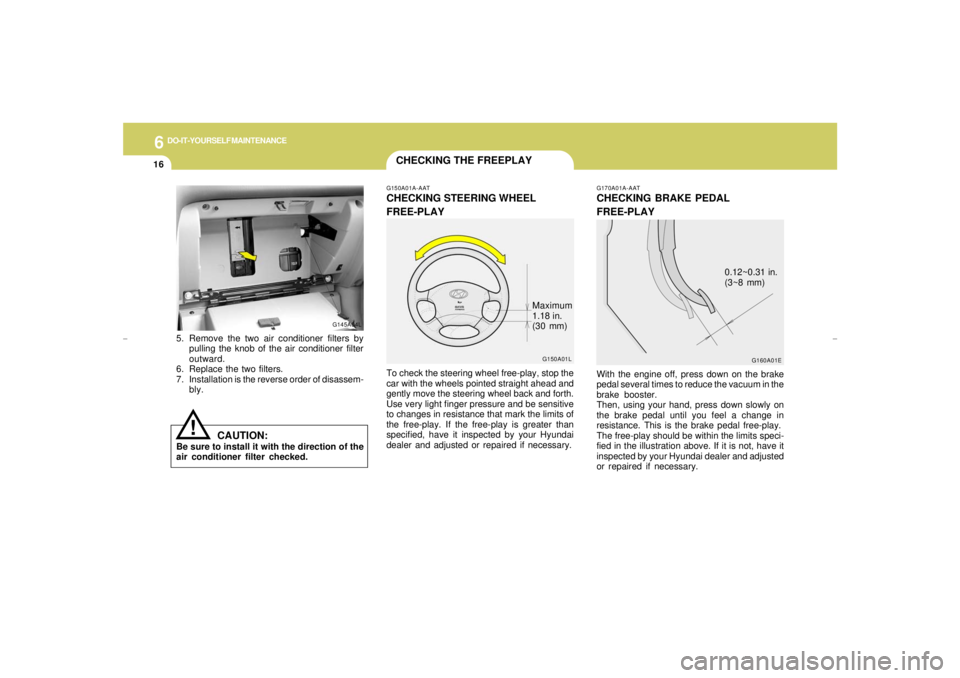
6
DO-IT-YOURSELF MAINTENANCE
16
CHECKING THE FREEPLAY
G170A01A-AATCHECKING BRAKE PEDAL
FREE-PLAYWith the engine off, press down on the brake
pedal several times to reduce the vacuum in the
brake booster.
Then, using your hand, press down slowly on
the brake pedal until you feel a change in
resistance. This is the brake pedal free-play.
The free-play should be within the limits speci-
fied in the illustration above. If it is not, have it
inspected by your Hyundai dealer and adjusted
or repaired if necessary.
G160A01E
0.12~0.31 in.
(3~8 mm)
G150A01A-AATCHECKING STEERING WHEEL
FREE-PLAYTo check the steering wheel free-play, stop the
car with the wheels pointed straight ahead and
gently move the steering wheel back and forth.
Use very light finger pressure and be sensitive
to changes in resistance that mark the limits of
the free-play. If the free-play is greater than
specified, have it inspected by your Hyundai
dealer and adjusted or repaired if necessary.
G150A01LMaximum
1.18 in.
(30 mm)
G145A04L
!
5. Remove the two air conditioner filters by
pulling the knob of the air conditioner filter
outward.
6. Replace the two filters.
7. Installation is the reverse order of disassem-
bly.
CAUTION:
Be sure to install it with the direction of the
air conditioner filter checked.
xgflhma-6.p656/16/04, 2:58 PM 16
Page 197 of 247

6
DO-IT-YOURSELF MAINTENANCE
17
CHECKING AND REPLACING
FUSES
CHECKING DRIVE BELTS
G180A01A-AATCHECKING BRAKE PEDAL
CLEARANCEYou need a helper to check the brake pedal
clearance. With the engine running, have your
helper press down on the brake pedal several
times and then hold it down with a force of about
110 lbs (50 kg, 490 N). The brake pedal clear-
ance is the distance from the top surface of the
brake pedal to the asphalt sheeting under the
floor mat.
If the brake pedal clearance is not within the
limits specified in the illustration, have it in-
spected by your Hyundai dealer and adjusted
or repaired if necessary.
G180A01L
2.95 in. (75 mm)
G190A01A-AATDrive belts should be checked periodically for
proper tension and adjusted if necessary. At the
same time, belts should be examined for cracks,
wear, fraying or other evidence of deterioration
and replaced if necessary.
Belt routing should also be checked to be sure
there is no interference between the belts and
other parts of the engine. After a belt is replaced,
the new belt should be adjusted again after two
or three weeks to eliminate slack resulting from
initial stretching after use.
G140D02L
Crank shaft pulley
A/C pulley Power steering pulley
Generator
G200A01Y-GATReplacing a Fusible LinkA fusible link will melt if the electrical circuits from
the battery are ever overloaded, thus prevent-
ing damage to the entire wiring harness. (This
could be caused by a short in the system
drawing too much current.) If this ever happens,
have a Hyundai dealer determine the cause,
repair the system and replace the fusible link.
The fusible links are located in a under hood
junction box for easy inspection.
G200A01LBad
Good
xgflhma-6.p656/16/04, 2:58 PM 17
Page 200 of 247
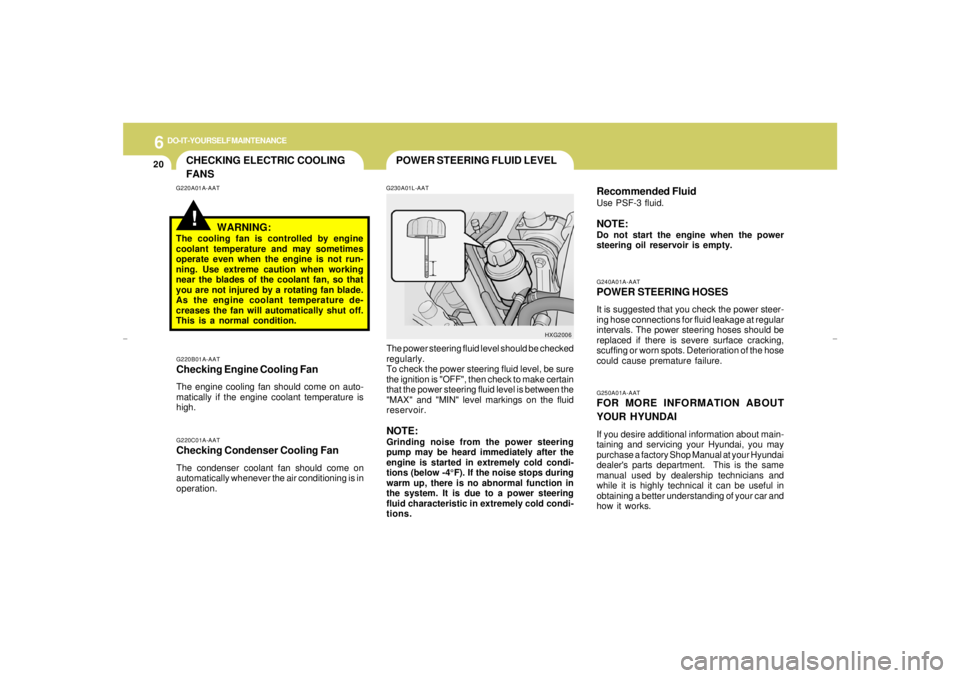
6
DO-IT-YOURSELF MAINTENANCE
20
POWER STEERING FLUID LEVEL
CHECKING ELECTRIC COOLING
FANS!
G250A01A-AATFOR MORE INFORMATION ABOUT
YOUR HYUNDAIIf you desire additional information about main-
taining and servicing your Hyundai, you may
purchase a factory Shop Manual at your Hyundai
dealer's parts department. This is the same
manual used by dealership technicians and
while it is highly technical it can be useful in
obtaining a better understanding of your car and
how it works.G240A01A-AATPOWER STEERING HOSESIt is suggested that you check the power steer-
ing hose connections for fluid leakage at regular
intervals. The power steering hoses should be
replaced if there is severe surface cracking,
scuffing or worn spots. Deterioration of the hose
could cause premature failure.
G230A01L-AAT
G220B01A-AAT
Checking Engine Cooling FanThe engine cooling fan should come on auto-
matically if the engine coolant temperature is
high.G220A01A-AAT
G220C01A-AATChecking Condenser Cooling FanThe condenser coolant fan should come on
automatically whenever the air conditioning is in
operation.
WARNING:
The cooling fan is controlled by engine
coolant temperature and may sometimes
operate even when the engine is not run-
ning. Use extreme caution when working
near the blades of the coolant fan, so that
you are not injured by a rotating fan blade.
As the engine coolant temperature de-
creases the fan will automatically shut off.
This is a normal condition.
The power steering fluid level should be checked
regularly.
To check the power steering fluid level, be sure
the ignition is "OFF", then check to make certain
that the power steering fluid level is between the
"MAX" and "MIN" level markings on the fluid
reservoir.
NOTE:Grinding noise from the power steering
pump may be heard immediately after the
engine is started in extremely cold condi-
tions (below -4°F). If the noise stops during
warm up, there is no abnormal function in
the system. It is due to a power steering
fluid characteristic in extremely cold condi-
tions.
HXG2006
Recommended FluidUse PSF-3 fluid.NOTE:Do not start the engine when the power
steering oil reservoir is empty.
xgflhma-6.p656/16/04, 2:59 PM 20
Page 201 of 247

6
DO-IT-YOURSELF MAINTENANCE
21
HEADLIGHT AIMING ADJUSTMENT
!
!
G290A03L-AATHID Type (If Installed)Before performing aiming adjustment, make
sure of the following.
G290A02L-A
Vertical
aiming1. Keep all tires inflated to the correct pressure.
2. Place the vehicle on level ground and press
the front bumper & rear bumper down sev-
eral times. Place vehicle at a distance of 118
in. (3m) from the test wall.
3. See that the vehicle is unloaded (except for
full levels of coolant, engine oil and fuel, and
spare tire, jack, and tools). Have the driver
or equivalent weight placed in driver's seat.
4. Clean the head light lenses and turn on the
headlights (Low beam).
5. Open the hood.
6. Draw the vertical line (through the center of
each headlight) and the horizontal line
(through the center of each headlight) on the
aiming screen.
And then, draw a parallel line at 0.8in.(21mm.)
under the horizontal line.
7. Adjust each cut-off line of the low beam to the
parallel line with a phillips screwdriver -
VERTICAL AIMING
WARNING:
If you need headlight aiming adjustment,
have your vehicle inspected by your Hyundai
Dealer.
Don't attempt to replace or inspect the HID
headlight bulb to prevent danger of an
electric shock.General Type
WARNING:
Horizontal aiming should be adjusted by an
authorized Hyundai Dealer.
G290B02L-AATAdjustment After Headlight Assembly
ReplacementIf the vehicle has had front body repair and the
headlight assembly has been replaced, the
headlight aiming should be checked using an
aiming screen as shown in the illustration. Turn
on the headlight switch. (Low Beam Position)
1. Adjust headlights so that main axis of light is
parallel to center line of the body and is
aligned with point "P" shown in the illustration.
2. Dotted lines in the illustration show center of
headlights.
G290B01L-A
LW
H
HCut-off line
Ground
line
"P" Horizontal lineVertical line
0.83 in. (21 mm)
xgflhma-6.p656/16/04, 2:59 PM 21
Page 243 of 247

10
INDEX
3
D
Defrosting / Defogging......................................................................1-83
Door
Door locks ...................................................................................... 1-4
Door courtesy light .......................................................................1-74
Locking and unlocking front doors with a key............................... 1-5
Drink Holder......................................................................................1-54
Drive Belts............................................................................... 6-14, 6-17
Driving
Smooth cornering .........................................................................2-12
Winter driving...............................................................................2-13
E
Emission Control System.......................................................... 7-1 ~ 7-4
Engine
Before starting the engine .............................................................. 2-3
Compartment................................................................................. 6-2
Coolant.................................................................................. 6-6 ~ 6-7
Coolant temperature gauge .........................................................1-44
If the engine overheats................................................................. 3-4
Number.......................................................................................... 8-3
Oil .................................................................................................. 6-4
Starting........................................................................................... 2-4
Engine Exhaust Can Be Dangerous................................................... 2-2F
Fan Speed Control ............................................................................1-79
Fog Light
Front.............................................................................................1-45
Front Seats
Adjustable front seats..................................................................1-10
Adjustable headrests ...................................................................1-11
Adjusting seat forward and rearward ..................................1-10, 1-13
Adjusting seatback angle.................................................... 1-11, 1-14
Lumbar support control ................................................................1-12
Seat cushion height adjustment.......................................... 1-12, 1-13
Seat warmer ................................................................................1-16
Fuel
Capacity......................................................................................... 9-2
Gauge..........................................................................................1-43
Recommendations......................................................................... 1-2
Fuel Filler Lid
Remote release .................................................................1-68 ~ 1-69
Manual.........................................................................................1-69
Fuses ..................................................................................... 6-17 ~ 6-18
G
General Checks.................................................................................. 6-3
Glove Box.........................................................................................1-60
xgflhma-10.p656/16/04, 3:01 PM 3